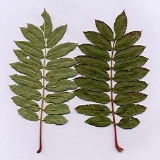
Sorbus cashmiriana
Encyclopedia
Sorbus cashmiriana is a species of rowan
native to the western Himalaya, including in Kashmir
.
It is a small, usually short-lived deciduous
tree
growing to 6–8 m tall, with a trunk up to 25 cm diameter. The bark
is smooth grey or red-grey. The leaves
are 15–23 cm long, pinnate
with 15–21 leaflets, dark green on top and lighter green underneath, the petiole
reddish, the leaflets 3–5.5 cm long and 1.5–2 cm broad, with a serrated margin. The flower
s are 7–10 mm diameter, with five very pale pink petals and pale yellowish stamens, produced in corymbs in the spring. Pollination
is by insect
s. The fruit
is a white to whitish-pink pome
12–15 mm diameter, ripening in the autumn and often persisting long after the leaf fall into winter.
Rowan
The rowans or mountain-ashes are shrubs or small trees in genus Sorbus of family Rosaceae. They are native throughout the cool temperate regions of the Northern Hemisphere, with the highest species diversity in the mountains of western China and the Himalaya, where numerous apomictic microspecies...
native to the western Himalaya, including in Kashmir
Kashmir
Kashmir is the northwestern region of the Indian subcontinent. Until the mid-19th century, the term Kashmir geographically denoted only the valley between the Great Himalayas and the Pir Panjal mountain range...
.
It is a small, usually short-lived deciduous
Deciduous
Deciduous means "falling off at maturity" or "tending to fall off", and is typically used in reference to trees or shrubs that lose their leaves seasonally, and to the shedding of other plant structures such as petals after flowering or fruit when ripe...
tree
Tree
A tree is a perennial woody plant. It is most often defined as a woody plant that has many secondary branches supported clear of the ground on a single main stem or trunk with clear apical dominance. A minimum height specification at maturity is cited by some authors, varying from 3 m to...
growing to 6–8 m tall, with a trunk up to 25 cm diameter. The bark
Bark
Bark is the outermost layers of stems and roots of woody plants. Plants with bark include trees, woody vines and shrubs. Bark refers to all the tissues outside of the vascular cambium and is a nontechnical term. It overlays the wood and consists of the inner bark and the outer bark. The inner...
is smooth grey or red-grey. The leaves
Leaf
A leaf is an organ of a vascular plant, as defined in botanical terms, and in particular in plant morphology. Foliage is a mass noun that refers to leaves as a feature of plants....
are 15–23 cm long, pinnate
Pinnate
Pinnate is a term used to describe feather-like or multi-divided features arising from both sides of a common axis in plant or animal structures, and comes from the Latin word pinna meaning "feather", "wing", or "fin". A similar term is pectinate, which refers to a comb-like arrangement of parts...
with 15–21 leaflets, dark green on top and lighter green underneath, the petiole
Petiole (botany)
In botany, the petiole is the stalk attaching the leaf blade to the stem. The petiole usually has the same internal structure as the stem. Outgrowths appearing on each side of the petiole are called stipules. Leaves lacking a petiole are called sessile, or clasping when they partly surround the...
reddish, the leaflets 3–5.5 cm long and 1.5–2 cm broad, with a serrated margin. The flower
Flower
A flower, sometimes known as a bloom or blossom, is the reproductive structure found in flowering plants . The biological function of a flower is to effect reproduction, usually by providing a mechanism for the union of sperm with eggs...
s are 7–10 mm diameter, with five very pale pink petals and pale yellowish stamens, produced in corymbs in the spring. Pollination
Pollination
Pollination is the process by which pollen is transferred in plants, thereby enabling fertilisation and sexual reproduction. Pollen grains transport the male gametes to where the female gamete are contained within the carpel; in gymnosperms the pollen is directly applied to the ovule itself...
is by insect
Insect
Insects are a class of living creatures within the arthropods that have a chitinous exoskeleton, a three-part body , three pairs of jointed legs, compound eyes, and two antennae...
s. The fruit
Fruit
In broad terms, a fruit is a structure of a plant that contains its seeds.The term has different meanings dependent on context. In non-technical usage, such as food preparation, fruit normally means the fleshy seed-associated structures of certain plants that are sweet and edible in the raw state,...
is a white to whitish-pink pome
Pome
In botany, a pome is a type of fruit produced by flowering plants in the subfamily Maloideae of the family Rosaceae.A pome is an accessory fruit composed of one or more carpels surrounded by accessory tissue...
12–15 mm diameter, ripening in the autumn and often persisting long after the leaf fall into winter.

